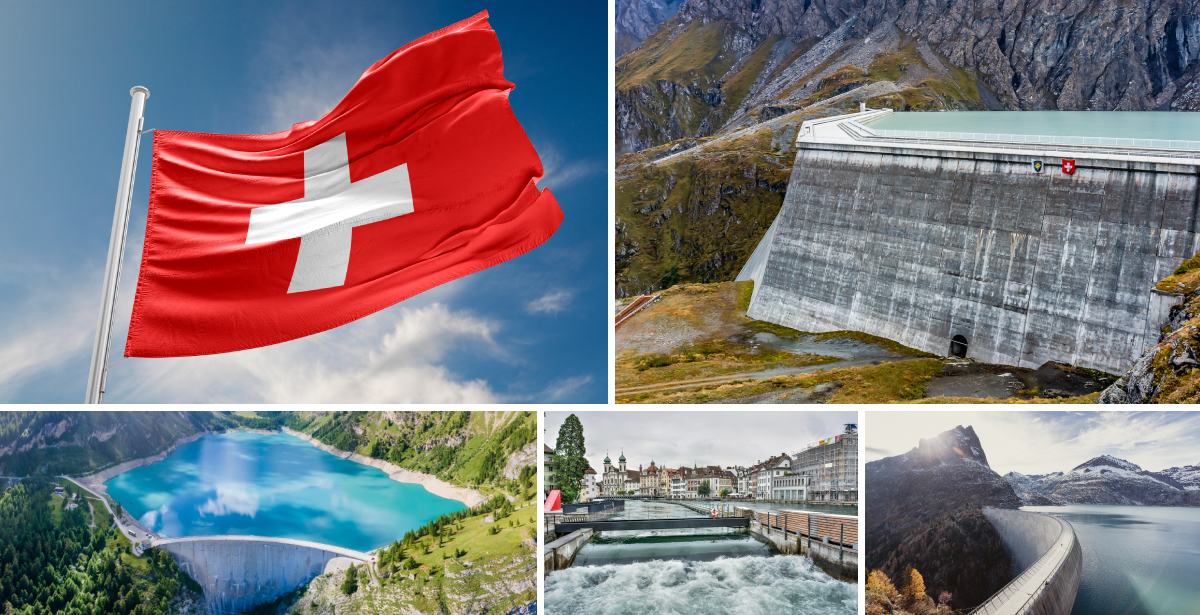Hydropower is one of the leading sources of renewable energy worldwide. Since the Paris Agreement and its net-zero target, several countries have increased their investments in the sector. They’re building new stations and upgrading old ones. Currently, nearly 16% of global electricity output comes from hydropower. In this article, we’ll discuss the pros and cons of hydroelectric power and talk about the situation of hydroelectric power in Switzerland.
Hydropower in Switzerland: History and Statistics
The country installed its first hydroelectric plants by the end of the 19th century when the technology was still a novelty. However, it was only between 1945 and 1970 that the country began to invest massively in its hydropower structure, expanding it significantly. Switzerland’s weather and topography make it a perfect place for exploring hydropower.

Indeed, about 90% of the domestic production came from hydropower in the 70s. However, figures began to drop in the subsequent years (in 1985, it was 60%; now it’s about 57%). Hydropower still stands as the main source of electricity for domestic purposes.
According to statistics from 2021, the country has 682 hydropower plants installed, with a capacity of 300 kilowatts and an average production of 37,172 GWh/y (gigawatt hours yearly).
Global events like the war in Ukraine and droughts have been pushing the government to expand its energy output and look for alternatives to fossil fuels. For this reason, the Swiss government has approved the construction of new hydroelectric power plants, as well as reserve power plants.
Switzerland’s Main Sources for Hydropower
Switzerland’s hydropower production relies mostly on its yearly volume of rainfall and also from the many rivers in the country and its borders. Indeed, run-of-the-river is the most common type of hydroelectric plant in the country, along with storage power plants. The first type corresponds to 48.3% of its production, while storage power plants are responsible for 47.5%.
Meanwhile, pumped storage plants correspond to only 4.2% of the hydroelectric output.
The cantons that contribute the most to the production of hydropower are Grisons, Uri, Valais, Ticino, Bern and Aargau. Learn more about each type below.
Run-of-the-River
Run-of-the-river plants are the first kind of hydroelectric power plants ever invented. Their principles are simple and effective. This kind of plant is built next to rivers, where turbines are installed to harness kinetic energy and transform it into electricity.
About 11% of the country’s hydropower generation comes from this type of facility. They’re installed on water bodies along Switzerland’s borders.
Pumped Storage
Pumped storage systems have less capacity than run-of-the-river ones. For this reason, pump station installation is mostly recommended for projects with low electricity demand.
A pumping station pumps water from a lower reservoir to an upper one. Then, this water is released from the upper part, which flows down, spinning the water turbines that generate energy. This process is only triggered in moments of increased demand for electricity.
Advantages and Disadvantages
Hydroelectric power plants use and generate clean energy based on the kinetic energy provided by rivers and other water bodies. Yet, from an environmental point of view, there are advantages and disadvantages of hydroelectric power plants. Key advantages include clean and renewable energy. Reservoirs can also be used for recreational purposes and flood control.
However, there are also environmental disadvantages of hydroelectric power plants. Reservoirs of impoundment facilities can affect fish populations, changing migratory and spawning habits. Hydroelectric power plants also affect the levels of dissolved oxygen in the water, which can be problematic for riverbank habitats.
Such problems can be addressed by creating passages for fish populations to move upstream and downstream within the system and also by using aeration techniques as compensation. Hydropower facilities are also threatened by drought since they can’t generate energy without water.
Switzerland’s Market Forecast for 2023
The Swiss Federal Electricity Commission (ElCom) expects an increase in prices for this year. According to the company, households are likely to face a rise of 27%, paying nearly CHF 27 c/kWh, which is CHF 6c/kWh more than the previous year.
Small businesses and medium-sized ones will also feel the impact, as prices are likely to rise by 24%. Consumers have been aware of the rise in prices since August 2022, when ElCom had to communicate the new tariffs and costs for 2023.

The Government of Switzerland is working on expanding energy capacity in 2023 and approved the construction of a hydroelectric power plant to create a power supply for the winter. The new investment comes amid concerns about interruptions of gas supply due to the war in Ukraine. The country aims to expand its hydropower output by 2 TW until 2040.
For the same reason, the government approved the construction of a new and temporary reserve power plant with a capacity of 250 MW in Birr, Aargau. It should be ready in February 2023. It’s a backup energy system which can be used in case of emergency. It’ll run on hydrogen, oil, or gas.
Hydroelectric Power Plants and Supplies by Premel
Premel has been a global leader in the hydroelectric power industry worldwide since 1947. The company was established in Switzerland and gained recognition over the years for the high quality of its products and services. Premel strictly abides by ISO 9001 standards, ensuring the trustworthiness of its supplies and professionals.
At Premel, you can count on a team of technicians and engineers from several fields, including environmental engineers. That’s why Premel becomes a partner to most of its clients, assisting them even after sales. Our company prides itself to be a one-stop station for water treatment and purification systems, industrial water treatment services, electrical panel upgrades, electrical panel replacement, and more.
Premel provides everything you need to make your project go forward. We have a wide array of technological solutions concerning hydropower generation and management. Become one of our partners and see everything Premel can do for the technological success of your project. Learn more about Hydroelectric Power Plants from Premel.
